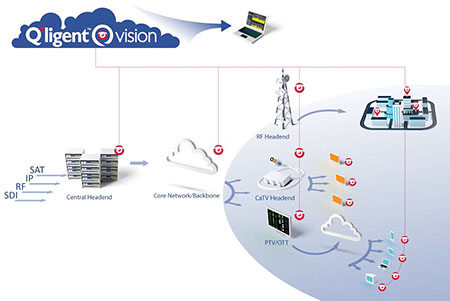IP Video, ATSC 3.0 Changing Test Protocol
ALEXANDRIA, VA.—The past two decades have seen a whirlwind of change in the broadcast industry, and the pace is accelerating. One of the big changes underway today is the wide acceptance of standard computer network technology for high-quality video distribution and transmission.
Referred to as IP networks (for Internet Protocol), these can do everything that SDI video can do and more, and generally do it for less money. If you think about it, IP technology is used in homes, businesses, industry and government offices worldwide, while SDI is a minor digital standard that is proprietary to the television industry.
That said, the transition to IP for video plants is still underway and there is much to be said for the reliability and fail-safe quality of SDI as compared to IP. However, IP has cost and flexibility in its favor, so greater adoption of IP will continue over the next few years and there will be some years when both IP and SDI will be equally important to broadcasters.

Omnitek Ultra XR UHD Video Waveform Rasterizer
ESSENTIAL ROLE
Test and measurement equipment for IP video plays an essential role in maintaining signal quality, as well as determining the cause and location of faults.
“Although the ultimate goal of broadcasters may be an all-IP infrastructure, the transition won’t happen overnight, leading to the need to manage hybrid IP and SDI workflows,” said Ronald Shung, product marketing manager for the video product line at Tektronix in Beaverton, Ore. “The ideal test and measurement solution for such a hybrid IP/SDI network is one that can perform a diverse variety of IP layer measurements, as well as monitor video and audio content. Cross-layer monitoring with familiar and easy-to-understand displays is critical to maintain signal quality across complex broadcast environments during the transition, while broadcast engineers are ramping up their skills in managing IP video networks.”
Once you’re in the IP world, your signals are still there but you have to think about them from a different angle.
The professional video industry's #1 source for news, trends and product and tech information. Sign up below.
“There are two main areas to consider when maintaining signal quality of IP-based material,” said Alan Wheable, communications manager at U.K.-based Omnitek. “First, there is the physical infrastructure itself, and second, there is the video/audio content being routed via the infrastructure.”
To ensure that the physical infrastructure is performing correctly, Wheable said it must have the bandwidth to be able to distribute the level of data required under all operational circumstances. Network analysis tools for this are already widely available. For dedicated SMPTE 2022-6 installations, working towards SMPTE 2110, there is equipment that allows the performance of individual links to be monitored.
To ensure that the image and audio quality of the program delivered over IP is at its optimum, SMPTE 2022-6-enabled test and measurement equipment is already available to allow all aspects of the program to be measured, monitored and logged.

Tektronix’ PRISM Hybrid IP/SDI Media Analysis Platform
4K PRODUCTION
With 4K production and routing making big inroads in television facilities, what is the impact of 4K-over-IP on test gear?
“One of the biggest benefits of an IP infrastructure is its flexibility to support future deployment of new technologies such as 4K, HDR and BT.2020 wide color gamut, just to name a few,” said Shung. “So IP test and measurement gear also needs to be future-ready, not just supporting the above-named technologies, but it needs to be able to support new evolving standards and technologies as well.”
Shung points out that software-based equipment can be updated to meet new standards. One example of this is Tektronix’s Prism hybrid IP/SDI analyzer.
Broadcasters already transmit multiple streams with the current ATSC 1.0 system, and the number of streams is likely to grow once the ATSC 3.0 standard is complete and begins to be adopted. ATSC 3.0 will allow different formats to be streamed, permitting more efficient use of a station’s spectrum. Stations may continue to transmit content encoded as MPEG-2, but this may change rapidly to H.264 and even H.265 (HEVC) to take advantage of those standards’ greater efficiency.
Since ATSC 3.0 treats content as IP streams, this means that IP data analyzers will be useful tools to keep tabs on what is being transmitted. One example of a system that can look at multiple streams of IP video encoded in various standards is the Bridge Technologies VB288 Objective QoE Content Extractor.

At the 2017 NAB Show Qligent debuted Vision-Field-CM, a cost-effective, entry-level version of its Vision cloud-based broadcast compliance and monitoring solution.
ATSC 3.0
Which brings up the topic of test and measurement for ATSC 3.0. We’ve already discussed one way in which it will be different from ATSC 1.0, but there are a variety of differences from monitoring the input data streams to testing a station’s RF output.
“Test and measurement for ATSC 3.0 will be very challenging because, even with 20 documented standards, there will be quite a bit of 'soft' problems introduced into the audio, video and data services by system configuration and interoperability,” said Ted Korte, chief operating officer of Melbourne, Fla.-based Qligent. “It will take some time before recommended practices for testing for ATSC 3.0 operation are available from the standards committees. For now, the best approach for this is historical profiling and trending of various configurations and operations.”
A looming over-the-air test for ATSC 3.0 will be the 2018 Winter Olympics in Korea. KBS plans to broadcast the event in 4K using transmitters beaming ATSC 3.0, and this means that test and measurement equipment has to be ready for the challenge.

Ted Korte, chief operating officer for Qligent
“They have a lot of smart people in place to make sure all goes well,” Korte said. “What is lacking in test gear will be made up with local experts with heavy hitters from Samsung and LG. The ATSC 3.0 goals for the Winter Olympics have been clear about certain must-have configurations, such as broadcasting in 4K via SFN, but less on some of the other features of ATSC 3.0. Having fewer variables will help determine what and how to test. Gear for testing the physical layer will be key, followed by testing for reception of the primary audio and video.”
Although any commercial deployment of ATSC 3.0 in the U.S. is at least a year off (and might be considerably more than that), understanding the test and measurement requirements will help broadcasters get a grasp on how different it is from the current standard.

Ralph Bachofen, vice president of sales and marketing for Triveni Digital
“ATSC 3.0 supports a variety of video formats and codecs, including 4K, 1080, HEVC, and HDR,” said Ralph Bachofen, vice president of sales and marketing at Princeton, N.J.- based Triveni Digital. “Broadcasters should make sure that their analyzer supports those options and/or is upgradable. It’s important to note that these new technologies might require fairly large performance envelopes, especially for rendering.” Bachofen gave a taste for what will be needed to properly test ATSC 3.0 transmissions.
“Broadcasters must ensure that their reception of ATSC 3.0, in RF, and all the signaling, announcement and other protocols are delivered per the standard specifications,” he said. “While RF reception is important for the delivery of content, signaling, announcement and other protocol aspects must be verified for proper display of content, enhanced user experience and FCC compliance [e .g., closed captioning].”
Many companies build test gear for IP video; fewer are currently manufacturing ATSC 3.0 test solutions. Some of the test gear manufacturers for IP video include Axon Digital, DekTek, Nevion, Sencore, Volicon, Video Clarity, Promax and Rohde & Schwarz. Both Qligent and Triveni Digital have test systems for ATSC 3.0, and we can expect more companies in this sector over in the near future.
Gone are the days when you could buy, say, a waveform monitor, and nurse 20 years of useful operation out of it. The gear is still well made and will last, but the standards and practices are shifting so quickly that a 10-year-old piece of test gear will be drifting into obsolescence.
Bob Kovacs is the former Technology Editor for TV Tech and editor of Government Video. He is a long-time video engineer and writer, who now works as a video producer for a government agency. In 2020, Kovacs won several awards as the editor and co-producer of the short film "Rendezvous."

